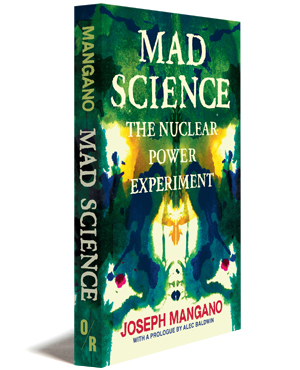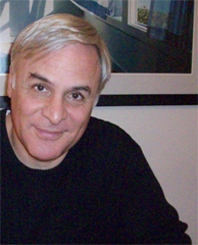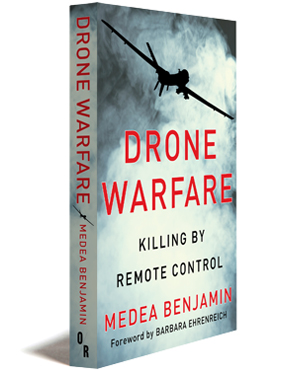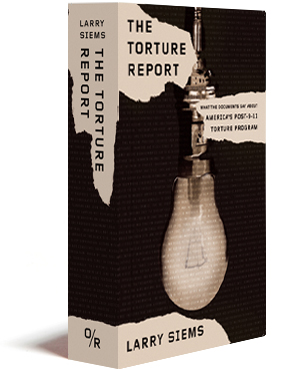
Mad Science
The Nuclear Power Experiment
Foreword by Alec Baldwin
"Joe Mangano is the constant, tireless voice that has helped keep me linked to reports from the front lines of the battle to expose the staggering risks to public health posed by nuclear power . . . Joe has been one of the most dedicated, intelligent and even-handed public activists I have ever known. He has also proven to be one of the most effective, on a battlefield where gains are measured in inches, if not centimeters." —from the foreword by Alec Baldwin
TweetBuy This Book
|
Paperback: $20/£13
|
E-book: $10/£7
|
Print + E-book: $24/£15
|
About the Book
Will Americans once again play nuclear roulette?
Just one year after the Fukushima meltdown, all 54 reactors in Japan have been closed, and may never be restarted. Germany recently closed several reactors, and will shutter them all within a decade. Italy revoked its pledge to build new reactors, keeping that nation nuclear-free. All these decisions are based on the understanding that reactors are extremely dangerous and expensive.
In the U.S., the remnants of the once-overwhelmingly powerful nuclear lobby are making their last stand for “clean” nuclear energy. The sixty-year-old vision of power “too cheap to meter” (words originally uttered by a banker promoting the industry) is back. While other countries end their reliance on nuclear energy, Americans contemplate its revival, even as existing reactors, which produce a fifth of U.S. electricity, pass retirement age and are corroding.
In Mad Science, Joseph Mangano strips away the near-smothering layers of distortions and outright lies that permeate the massive propaganda campaigns on behalf of nuclear energy. He explores the history of the industry, with its origins in the Manhattan Project, through its heightening promotion during the Cold War and its entwinement with nuclear weapons.
Mad Science includes an account of nuclear accidents and meltdowns and their consequences, from Chernobyl to Santa Susana and beyond; as well as a point-by-point refutation of pro-nuke arguments. Atomic energy is unsafe – it deals with staggeringly poisonous substances at every stage of its creation – un-economical in the extreme and impractical.
Publication October 2012 • 336 pages
paperback ISBN 978-1-935928-85-0 • ebook ISBN 978-1-935928-86-7
About the Author

Photo of Joseph Mangano © Susan Burke
|
Joseph Mangano directs the Radiation and Public Health Project (RPHP), an independent group of scientists and health professionals dedicated to research and education of health hazards from nuclear reactors and weapons. While at RPHP, he has written or co-written dozens of articles in medical/scientific journals. Mangano is the author of Low-Level Radiation and Immune System Damage: An Atomic Era Legacy (1998) and Radioactive Baby Teeth: The Cancer Link (2008). He played a prominent role in the Tooth Fairy Project, a study of Strontium-90 levels in 5,000 baby teeth, which remains the only study of radiation levels in bodies of Americans living near nuclear plants. Mangano holds a Masters degree in Public Health from the University of North Carolina and an MBA from Fordham University. |
In the Media
Read an Excerpt
On a warm California morning – July 12, 1959 – just outside Los Angeles, workers at the experimental nuclear reactors at the Santa Susana Field Laboratory reported for duty. Those who worked on the Sodium Reactor Experiment, one of ten reactors at the lab, were eager to make the fourteenth in a series of tests of the futuristic machine. The experiment tried to cool uranium fuel in the reactor core with sodium rather than the standard method, which used water. Hopes were high that this design would revolutionize atomic power reactors in the US, and perhaps around the world.
There had been problems with the first thirteen tests over the past two years. In the most recent one, there had been an explosion. The inexperienced workers tried to find its cause, but were unsuccessful. In retrospect, leaks had probably limited the ability to keep the sodium cool – a crucial aspect of running the reactor safely. But instead of taking the prudent path of stopping or postponing the test series, Test 14 was placed right on schedule, with no delays.
Almost immediately after work began, something went badly wrong. The sodium was not cooling the reactor core, which heated up to levels never seen before at Santa Susana – or perhaps in the US. Inside the core were long rods, containing uranium atoms that were split to power the reactor, along with the dozens of dangerous radioactive chemicals formed as waste products when uranium atoms are split. The long rods began to melt, and a large volume of radioactive gas built up in the reactor room. Instead of shutting down the reactor and investigating the cause, technicians added additional rods designed to control the process, but these only made the situation worse.
The next two weeks were a series of re-starts and more melting down, similar to repeatedly banging one’s head against a brick wall. Why didn’t managers shutdown the Sodium Reactor Experiment? The answer was one common to the US atomic power program; adherence to a mentality of “the show must go on” in spite of any dangers. Every day, radioactive gases from holding tanks in the reactor building were released into the air – often at night, a highly toxic job given to workers on the “graveyard shift.” Finally, two weeks to the day after the run started, the reactor was finally shut down. The amount of radiation released into the environment was never accurately measured – in fact the entire meltdown was kept secret from the public for the next two decades. Sodium cooled reactors failed; of the 439 reactors operating worldwide today, only two are sodium cooled (none in the US). But the damage had been done, and today the Santa Susana site sits amidst a large mess of toxic waste.
The meltdown at Santa Susana is a microcosm of the entire US nuclear power program. It began with great enthusiasm for what the technology could do – so much enthusiasm that when problems began piling up, those in charge kept the program moving, convinced that the atom would be the answer to America’s future energy problems. But it wasn’t then, still isn’t, and never will be. The American nuclear power program is a failure. Why did nukes fare so poorly? Why were they allowed to cause such damage, and how is it the debate still continues? How a technology with such promise was allowed to cause such huge threats and ring up a staggeringly high tab in the process can only be understood by examining its origins.
On a December day in 1953, President Dwight D. Eisenhower stood before the United Nations to deliver a critical speech on nuclear power. Eisenhower had been President less than a year, but had already become a crucial figure in the Cold War between capitalist and communist nations. Perhaps his most important achievement was that he had helped broker an end to the Korean War, permanently splitting that nation into two countries, the communist north and the capitalist south. Just one month after Eisenhower took office, Soviet dictator Joseph Stalin died, bringing the Cold War to another phase, one that offered more hope for reconciliation.
Eisenhower presented a complex figure. He was a military man by training and experience, a graduate of West Point and a lionized figure who had served as a junior officer in the first World War, and as the supreme commander of all Allied troops in Europe during the second, elevating him to heroic status. Some worried about a soldier occupying the White House during this time. The military mindset during the early years of the Cold War was based on a strict interpretation of America’s ability to maintain military superiority. This superiority extended to nuclear weapons; the US had produced and used the first bombs, and those in the military community believed they should be used freely, despite the horrors at Hiroshima and Nagasaki.
Just four years after Hiroshima and Nagasaki, the Soviet Union developed its own bomb, and successfully detonated it. In late 1952, the US exploded a thermonuclear (hydrogen) device, with explosive power 1,000 times greater than an atomic weapon. But just nine months later, the Soviets exploded their own super-bomb. The US had lost its monopoly, but maintained superiority in the numbers game. In the race to test and manufacture as many as possible as quickly as possible, an all-out effort gave America the lead. By the end of 1953, the US had tested forty-four bombs to the Soviet total of just three. The US had amassed about 1,000 nuclear weapons, while the Soviets had just a handful. And the United Kingdom, allied with America, had also begun testing and stockpiling nuclear weapons. A number of military leaders believed that nuclear war was inevitable, and even should proceed while the US had such superior numbers.
The modest sense of security that a monopoly on atomic weapons gave people was ebbing, even though a lead was maintained in the count of nuclear weapons. The image of a hostile communist regime exploding an atomic bomb and then building a stockpile of these weapons was disturbing to many Americans. Scientists began to look beyond current numbers and envision a fearful situation, with both nations able to destroy the other through attacks that were indefensible. A group at the University of Chicago instituted the “Doomsday Clock” to measure proximity to global disaster. The initial 1947 setting of seven “minutes to midnight” was reduced to two minutes by 1953 as the arms race heated up.
Had Eisenhower subscribed to the military model, he would have taken the aggressive stance that it was possible, even desirable, to “win” an inevitable nuclear war. A part of his policy fit this model. He continued Harry Truman’s program of developing a large arsenal of nuclear weapons with the utmost speed. A series of eleven above-ground atomic bomb explosions had taken place in Nevada during the spring of 1953, and similar programs would follow in 1955, 1957, and 1958. Another series of shots were being planned for the Marshall Islands in the south Pacific, including what would be a hydrogen bomb with an equivalent yield of 1,000 Hiroshima bombs (Norris and Cochran). During Eisenhower’s eight years in office, the number of US nuclear weapons grew from 1,000 to 20,000.
But the new President was a complex man, not easily categorized, who deviated from a completely hard-line policy. He had been shaken by the carnage of the recently-ended World War, and had opposed Truman’s usage of nuclear weapons on mostly civilian targets in the Japanese cities of Hiroshima and Nagasaki.
In 1945 Secretary of War Stimson, visiting my headquarters in Germany, informed me that our government was preparing to drop an atomic bomb on Japan. I was one of those who felt that there were a number of cogent reasons to question the wisdom of such an act. . . first on the basis of my belief that Japan was already defeated. . . and secondly because I thought that our country should avoid shocking world opinion by the use of a weapon whose employment was, I thought, no longer mandatory as a measure to save American lives.
He also understood the growing public fear over the nuclear arms race. So Eisenhower’s mission to the U.N. that December day was to soothe fears. He could not get around the fact that the atom represented a devastating power the world had never seen, nor could he deny that a race for nuclear superiority between two hostile nations was under way and was gathering momentum. However, he could inform the public that there were uses of this new technology that would help, rather than harm, humans – thus giving rise to the phrase “peaceful atom.”





